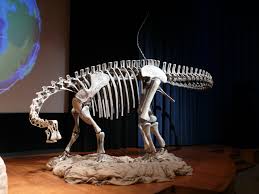Dinosaurs are a group of fascinating prehistoric creatures that have captured the imaginations of both scientists and the general public for centuries. With their enormous size, incredible strength, and diverse features, these ancient reptiles adapted incredibly well to their environments. One of the most striking aspects of some dinosaurs is their teeth – whether large, sharp, or numerous. Among the many jaw-dropping features in the dinosaur kingdom, one stands out mainly for its astonishing number of teeth: the Nigersaurus. This remarkable dinosaur is known for having an extraordinary 500 teeth, which has intrigued paleontologists and enthusiasts alike. In this article, we will explore the mysteries of the Nigersaurus, its 500 teeth, and how it contributes to our understanding of dinosaur evolution.
The Dinosaur with 500 Teeth: Introduction to the Creature
The Nigersaurus, often called the “Mesozoic lawnmower,” was a relatively small and peaceful herbivorous dinosaur that lived around 115 to 105 million years ago, during the Early Cretaceous period. It roamed what is now modern-day Niger in North Africa, where the fossilized remains of this extraordinary dinosaur were discovered. Despite its unusual appearance and relatively smaller size than some of its contemporaries, such as the massive Tyrannosaurus rex or the iconic Triceratops, the Nigersaurus’s 500 teeth make it one of the most memorable dinosaurs.
The Nigersaurus was part of a group of dinosaurs known as sauropodomorphs: plant-eating, long-necked dinosaurs. While it wasn’t as massive as some relatives, it stood out because of its specialized features. With a length of around 30 feet (9 meters), it had a relatively short neck and a long, low head, making it well-adapted to grazing on low-lying vegetation. What truly sets this dinosaur apart, however, is its unique and abundant dental structure. With approximately 500 teeth packed in its jaw, the Nigersaurus was equipped with one of the most specialized feeding mechanisms in the dinosaur kingdom.
Unique Features of Nigersaurus’s Teeth
The most striking feature of the Nigersaurus is, of course, its teeth. It had a remarkable dental structure, with many teeth constantly replacing themselves throughout its lifetime. Unlike many other herbivorous dinosaurs, which had large, flat teeth suited for grinding tough plants, the Nigersaurus’s teeth were specialized for shearing, similar to a scythe. Its teeth were relatively small and evenly spaced, arranged in a broad, horizontal row, allowing it to scrape plant material precisely.
This dinosaur’s teeth were remarkably well adapted for eating vegetation that grew close to the ground. The Nigersaurus likely fed on low-lying ferns, grasses, and other vegetation, which it could effortlessly cut and shear thanks to its teeth’ specialized shape and placement. Unlike most herbivores that might chew their food in a vertical motion, the Nigersaurus’s teeth worked more horizontally, giving it the ability to graze on plants found in its environment efficiently.
The Nigersaurus’s teeth were also part of a more extensive dental “battery.” This feature is a significant adaptation for herbivores, where teeth are constantly replaced throughout the animal’s life. The Nigersaurus had an array of teeth in multiple stages of wear, ensuring it always had fresh teeth available for feeding. This constant tooth replacement enabled the dinosaur to remain efficient in gathering food over its lifetime.
The Evolutionary Significance of Having 500 Teeth

Having 500 teeth may seem excessive, but in the case of the Nigersaurus, this feature had significant evolutionary advantages. The sheer number of teeth allowed this dinosaur to survive in an environment where vegetation was abundant but often challenging to access or digest. The Nigersaurus was a specialized herbivore, and its numerous teeth helped it to maximize its ability to feed on vegetation that may have been difficult for other herbivores to consume.
The Nigersaurus’s teeth were numerous and fine-tuned to its environment. The abundance of teeth meant that the dinosaur could continue grazing without interruption, ensuring its nutritional needs were met. For an animal of its size and feeding habits, having this many teeth helped it take advantage of the plant life around it in ways that its contemporaries could not.
This unique adaptation highlights the pressures of evolution and how different species evolve in response to the availability of food and the challenges they face in their environment. In the case of the Nigersaurus, having 500 teeth was likely an adaptation to the specific vegetation and the competition with other herbivores, enabling it to thrive in the Cretaceous period.
The Fossil Evidence and Discoveries of Nigersaurus
The discovery of the Nigersaurus was a groundbreaking moment in paleontology. Fossils of this dinosaur were first unearthed in 2000 in the Tenere Desert of Niger, an area that is known for its rich fossil record. The Nigersaurus remains were discovered by a team led by Dr. Paul Sereno, a prominent paleontologist who has made several significant discoveries in the field of dinosaur research.
The most impressive aspect of the Nigersaurus’s discovery was the preservation of its teeth, which provided crucial insights into its feeding behavior and unique dental structure. Thanks to the fossil evidence, paleontologists could reconstruct the dinosaur’s skull and jaw, revealing its distinctive dental battery and the arrangement of its teeth. These findings were essential in understanding how the Nigersaurus used its teeth to feed on low-lying plants and how its dental adaptations contributed to its survival.
In addition to the Nigersaurus’s teeth, other aspects of its fossilized remains have helped researchers learn more about its overall anatomy, including its body structure, posture, and possible behavior. The ongoing study of these fossils continues to provide valuable information about life in the Early Cretaceous period and the ecological dynamics of that time.
Conclusion
The Nigersaurus is an extraordinary example of the diversity and specialization among dinosaurs. With its 500 teeth, it is one of the most remarkable herbivores from the Cretaceous period. This dinosaur’s specialized dental structure allowed it to feed on low-lying vegetation efficiently, giving it a competitive advantage over other herbivores. The discovery of the Nigersaurus has shed light on how certain dinosaurs evolved in response to their environments, providing insights into the complex ecosystems of the Mesozoic era.
The Nigersaurus highlights the fascinating evolutionary paths dinosaurs took to adapt to their surroundings through its unique features. This remarkable dinosaur not only captured the attention of paleontologists but also served as a testament to the incredible variety of life that once roamed the Earth.
FAQs
What did Nigersaurus eat with its 500 teeth?
The Nigersaurus was a herbivore that likely fed on low-lying plants, ferns, and grasses, using its specialized teeth to shear and scrape vegetation efficiently.
Was Nigersaurus the only dinosaur with 500 teeth?
No, while Nigersaurus is the most famous for its 500 teeth, other herbivorous dinosaurs also had numerous teeth, though none had as many as Nigersaurus.
Why did Nigersaurus have so many teeth?
The countless teeth helped Nigersaurus efficiently process and feed on abundant but thorny low-lying vegetation, providing a constant source of nutrition.
How significant was Nigersaurus, and where was it found?
Nigersaurus was approximately 30 feet long and was discovered in the Tenere Desert of Niger, Africa.
How do paleontologists know about the 500 teeth of Nigersaurus?
Paleontologists learned about the 500 teeth through fossil discoveries, which provided critical insights into the dinosaur’s feeding mechanism and unique dental structure.
Did Nigersaurus have any other unique features besides its teeth?
Besides its teeth, Nigersaurus had a low, long head and neck, ideal for grazing on low-lying vegetation, and a relatively small, lightweight body.
When did Nigersaurus live, and what other dinosaurs were around simultaneously?
Nigersaurus lived around 115 to 105 million years ago in the Early Cretaceous period, alongside dinosaurs like Spinosaurus and Carcharodontosaurus.




